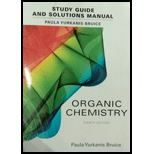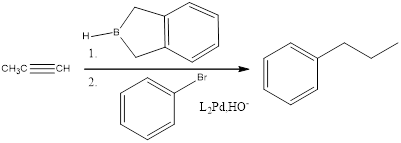
(a)
Interpretation:
The product of the given reaction has to be determined.
Concept introduction:
Suzuki reaction:
A reaction that couples an aryl halide or vinyl halide with an Organoboron reagent.
Heck reaction:
A reaction that breaks the double bond of an
Organoborane compound:
An alkyl–organoboron compound, an alkenyl–Organoboron compound, or an aryl–Organoboron compound:
Coupling reaction:
A reaction that joins two groups with a carbon-carbon bond.
(a)
Explanation of Solution
When a Iodobenzene is treated with alkene in presence of HeeK Reagent to form the correspondng the benzene product.

(b)
Interpretation:
The product of the given reaction has to be determined.
Concept introduction:
Suzuki reaction:
A reaction that couples an aryl halide or vinyl halide with an Organoboron reagent.
Heck reaction:
A reaction that breaks the double bond of an alkene and then joins the fragments.
Organoborane compound:
An alkyl–organoboron compound, an alkenyl–Organoboron compound, or an aryl–Organoboron compound:
Coupling reaction:
A reaction that joins two groups with a carbon-carbon bond.
(b)
Answer to Problem 27P

Explanation of Solution
When a Complex of benzene is treated with ethylene oxide to form the correspondng the alcoholic benzene product.

(c)
Interpretation:
The expected product should be formed by the following reaction.
Concept introduction:
Suzuki reaction:
A reaction that couples an aryl halide or vinyl halide with an Organoboron reagent.
Heck reaction:
A reaction that breaks the double bond of sa alkene and then joins the fragments.
Organoborane compound:
An alkyl –organoboron compound, an alkenyl –Organoboron compound, or an aryl –Organoboron compound:
Coupling reaction:
A reaction that joins two groups with a carbon-carbon bond.
(c)
Answer to Problem 27P

Explanation of Solution
Chloro benzene is treated with alkyl substituted CuLi reagent to give the corresponding product.

(d)
Interpretation:
The expected product should be formed by the following reaction.
Concept introduction:
Suzuki reaction:
A reaction that couples an aryl halide or vinyl halide with an Orghanoboron reagent.
Heck reaction:
A reaction that breaks the double bond of sa alkene and then joins the fragments.
Organoborane compound:
An alkyl –organoboron compound, an alkenyl –Organoboron compound, or an aryl –Organoboron compound:
Coupling reaction:
A reaction that joins two groups with a carbon-carbon bond.
(d)
Answer to Problem 27P

Explanation of Solution
When a Iodobenzene is treated with

(e)
Interpretation:
The expected product should be formed by the following reaction.
Concept introduction:
Suzuki reaction:
A reaction that couples an aryl halide or vinyl halide with an Organoboron reagent.
Heck reaction:
A reaction that breaks the double bond of sa alkene and then joins the fragments.
Organoborane compound:
An alkyl – organoboron compound, an alkenyl –Organoboron compound, or an aryl –Organoboron compound:
Coupling reaction:
A reaction that joins two groups with a carbon-carbon bond.
(e)
Answer to Problem 27P

Explanation of Solution
When a bromo benzene treated with a brane complecx in presence of Heek reagent to give the corresponding product.

(f)
Interpretation:
The expected product should be formed by the following reaction.
Concept introduction:
Suzuki reaction:
A reaction that couples an aryl halide or vinyl halide with an Organoboron reagent.
Heck reaction:
A reaction that breaks the double bond of an alkene and then joins the fragments.
Organoborane compound:
An alkyl–organoboron compound, an alkenyl–Organoboron compound, or an aryl–Organoboron compound:
Coupling reaction:
A reaction that joins two groups with a carbon-carbon bond.
(f)
Answer to Problem 27P

Explanation of Solution
When an

Want to see more full solutions like this?
Chapter 11 Solutions
Student's Study Guide and Solutions Manual for Organic Chemistry
- Problem 6-29 Identify the functional groups in the following molecules, and show the polarity of each: (a) CH3CH2C=N CH, CH, COCH (c) CH3CCH2COCH3 NH2 (e) OCH3 (b) (d) O Problem 6-30 Identify the following reactions as additions, eliminations, substitutions, or rearrangements: (a) CH3CH2Br + NaCN CH3CH2CN ( + NaBr) Acid -OH (+ H2O) catalyst (b) + (c) Heat NO2 Light + 02N-NO2 (+ HNO2) (d)arrow_forwardPredict the organic product of Y that is formed in the reaction below, and draw the skeletal ("line") structures of the missing organic product. Please include all steps & drawings & explanations.arrow_forwardPlease choose the best reagents to complete the following reactionarrow_forward
- Problem 6-17 Look at the following energy diagram: Energy Reaction progress (a) Is AG for the reaction positive or negative? Label it on the diagram. (b) How many steps are involved in the reaction? (c) How many transition states are there? Label them on the diagram. Problem 6-19 What is the difference between a transition state and an intermediate? Problem 6-21 Draw an energy diagram for a two-step reaction with Keq > 1. Label the overall AG°, transition states, and intermediate. Is AG° positive or negative? Problem 6-23 Draw an energy diagram for a reaction with Keq = 1. What is the value of AG° in this reaction?arrow_forwardProblem 6-37 Draw the different monochlorinated constitutional isomers you would obtain by the radical chlorination of the following compounds. (b) (c) Problem 6-39 Show the structure of the carbocation that would result when each of the following alkenes reacts with an acid, H+. (a) (b) (c)arrow_forwardPlease draw the major product of this reaction. Ignore inorganic byproducts and the carboxylic side productarrow_forward
- predict the product formed by the reaction of one mole each of cyclohex-2-en-1-one and lithium diethylcuprate. Assume a hydrolysis step follows the additionarrow_forwardPlease handwriting for questions 1 and 3arrow_forwardIs (CH3)3NHBr an acidic or basic salt? What happens when dissolved in aqueous solution? Doesn't it lose a Br-? Does it interact with the water? Please advise.arrow_forward
 ChemistryChemistryISBN:9781305957404Author:Steven S. Zumdahl, Susan A. Zumdahl, Donald J. DeCostePublisher:Cengage Learning
ChemistryChemistryISBN:9781305957404Author:Steven S. Zumdahl, Susan A. Zumdahl, Donald J. DeCostePublisher:Cengage Learning ChemistryChemistryISBN:9781259911156Author:Raymond Chang Dr., Jason Overby ProfessorPublisher:McGraw-Hill Education
ChemistryChemistryISBN:9781259911156Author:Raymond Chang Dr., Jason Overby ProfessorPublisher:McGraw-Hill Education Principles of Instrumental AnalysisChemistryISBN:9781305577213Author:Douglas A. Skoog, F. James Holler, Stanley R. CrouchPublisher:Cengage Learning
Principles of Instrumental AnalysisChemistryISBN:9781305577213Author:Douglas A. Skoog, F. James Holler, Stanley R. CrouchPublisher:Cengage Learning Organic ChemistryChemistryISBN:9780078021558Author:Janice Gorzynski Smith Dr.Publisher:McGraw-Hill Education
Organic ChemistryChemistryISBN:9780078021558Author:Janice Gorzynski Smith Dr.Publisher:McGraw-Hill Education Chemistry: Principles and ReactionsChemistryISBN:9781305079373Author:William L. Masterton, Cecile N. HurleyPublisher:Cengage Learning
Chemistry: Principles and ReactionsChemistryISBN:9781305079373Author:William L. Masterton, Cecile N. HurleyPublisher:Cengage Learning Elementary Principles of Chemical Processes, Bind...ChemistryISBN:9781118431221Author:Richard M. Felder, Ronald W. Rousseau, Lisa G. BullardPublisher:WILEY
Elementary Principles of Chemical Processes, Bind...ChemistryISBN:9781118431221Author:Richard M. Felder, Ronald W. Rousseau, Lisa G. BullardPublisher:WILEY





